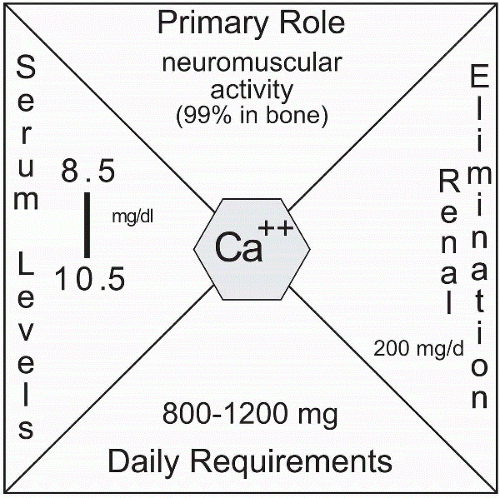Calcium
QUICK LOOK AT THE CHAPTER AHEAD
Calcium is a mineral that helps to build and maintain the bones and teeth, regulate the heart’s rhythm, transmit nerve impulses, and assist with blood clotting. The body gets calcium through food sources and by borrowing it from the bones when calcium blood levels are low. The normal range for total serum calcium is 8.5-10.5 mg/dL or 4.5-5.5 mEq/L. In this chapter we describe the functions of calcium and how it is regulated and maintained.
The normal range for total serum calcium is 8.5-10.5 mg/dL or 4.5-5.5 mEq/L. Ninety-nine percent of calcium is located in the bones and teeth and is responsible for the formation and firm structure of these body parts. This leaves 1% of calcium in the cells and fluid compartments, with the majority of that 1% in the extracellular compartment. Forty-one percent of this extracellular calcium is bound to the protein albumin. Therefore when albumin levels decline, so do calcium levels. A small percentage is bound to citrate and other small organic ions. The remainder of calcium is ionized (unbound). The
normal value for ionized calcium is 4.5-5.1 mg/dL or 2.2-2.5 mEq/L. This ionized or free calcium conducts the physiological functions, and any imbalances in the levels of ionized calcium result in hypocalcemia or hypercalcemia. Calcium functions in cellular permeability and in the contraction of cardiac, smooth, and skeletal muscles. It also plays a role in the blood-clotting process.
normal value for ionized calcium is 4.5-5.1 mg/dL or 2.2-2.5 mEq/L. This ionized or free calcium conducts the physiological functions, and any imbalances in the levels of ionized calcium result in hypocalcemia or hypercalcemia. Calcium functions in cellular permeability and in the contraction of cardiac, smooth, and skeletal muscles. It also plays a role in the blood-clotting process.
Stay updated, free articles. Join our Telegram channel

Full access? Get Clinical Tree



